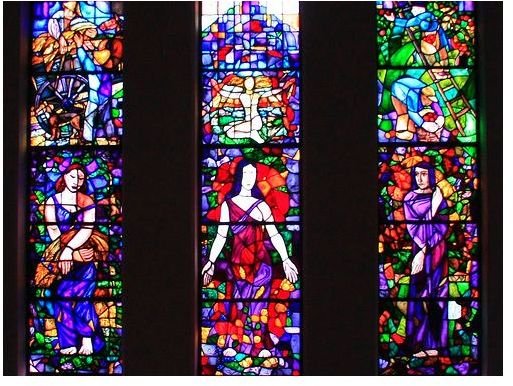Digital Photography Tutorial: How to Take a Photo in Front of a Stained Glass Window
Photographing Stained Glass Windows
Stained glass is an amazing feat of human ingenuity. Capturing a photograph in front of a stained glass window often leads to major problems, though. Your flash reflects off the glass diminishing its look and causing bulb reflections in the glass. You are faced with a question: how to take a photo in front a stained glass window so that it truly captures the beauty?
Time of Day to Photograph Stained Glass
The first answer to that question is simply to shut off your camera flash. It is more headache than help. Instead, use natural lighting. Avoid photographing stained glasses on bright, sunny days. Direct sunlight does not provide even lighting, which causes shadows on the window.
Instead, shoot on overcast days. You will still receive plenty of lighting, but the lighting will be filtered. You will lose the harsh shadows, but still illuminate the stained glass.
The only time that you should take photographs of stained glasses on a sunny day is if you want to capture reflected colors from the stained glass. As the sunlight shines through the glass, it will cause cascades of rainbow-like lighting on floors, statues and anything else in its path. This creates some interesting pictures.
Camera Settings
Manipulate the ISO if you are inside a building. Generally, about an f/8 stop is good for photographing indoors, but you need to experiment to determine exactly what will work with the particular stained glass you are photographing. In addition, try to use manual exposure as opposed to automatic. Your camera does its best to compensate for the light coming through the window and the darkness of the interior, but it is not perfect.
Try changing your exposure to between -0.5 and -1. If you do not know how to change your exposure, then you will have to refer to your handy camera manual. It should be in your settings along near your ISO settings. It is best to underexpose your images slightly, since doing so will show more of the colors. Again, you will have to do some experimentation to figure out what exposure setting will work best.
Outside Looking In
Another interesting way to photograph stained glasses is photographing from the outside, especially at night. This technique works well if you are photographing churches or older buildings. Generally, the light in these buildings are poor. At night, that little bit of lighting is enough to capture the stained glass.
For this type of photography, manipulate the exposure and ISO again. You may be able to use the same settings. Avoid using your flash.
Equipment
The goal is to capture as much of the stained glass as possible. When you cannot capture the entire window, use a telephoto lens and focus on certain sections or details of the stained glass. Set up your camera on a tripod and compensate for the angle of the stained glass. If the stained glass angles outwards or inwards, adjust the tripod and your lens until the stained glass fills the frame and looks straight.
Finally, take lots of pictures, and do not be afraid to experiment.
References
WELS Stained Glass, https://www.welsstainedglass.org/WordPDFDocuments/HowToTakePics.pdf
Pratanti, https://www.flickr.com/photos/pratanti/3685286175/sizes/m/in/photostream/
